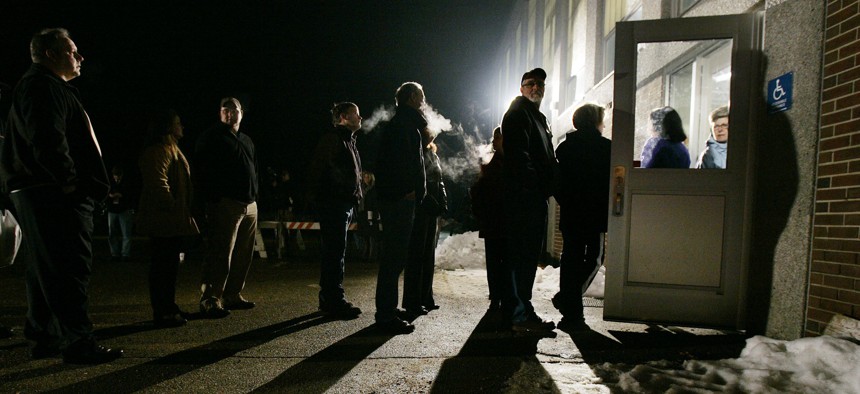It’s Time for Regional Primaries

Voters line up to vote in New Hampshire. Elise Amendola / AP File Photo

Connecting state and local government leaders
In a guest article, Connecticut Secretary of State Denise Merrill explores how her colleagues around the country are now working together to develop a more harmonized, coherent nomination process after a plan for regional primaries didn’t take off years ago.
HARTFORD, Conn. — After a number of states enjoyed relevant primaries for the first time in many years, elections officials are feeling … well … neighborly.
As we wrap up the conventions celebrating our respective nominees, now is a good time to reflect on a grueling, thrilling, chaotic, engaging and incredibly confusing primary season.
My home state of Connecticut had the rare experience of voting in primaries that were of critical importance to both Democrats and Republicans. We enjoyed rallies held by leading candidates and celebrated the chance to be part of history.
It felt so good that we’d like to repeat the experience in future primaries.
Usually—like so many other states—by the time our primaries are held, the contest is mostly decided.
That isn’t fair.
It isn’t fair to the voters, who may want to see their issues debated in a meaningful way. It isn’t fair to the armies of volunteers, who must travel to other states to feel like valued members of the campaigns. I like to think it isn’t fair to the candidates who would actually want to visit our beautiful state and get to know the people they may soon govern.
Back in 1998, the National Association of Secretaries of State devised a plan to hold rotating, regional primaries. The East, South, Midwest and West would have a chance to hold contests in March, April, May and June.
They would rotate every four years, giving each region a chance to go first.
The plan for a regional primary system never took off, but many secretaries of state around the country are now working together to develop a more harmonized, coherent nomination process.
Georgia Secretary of State Brian Kemp was the architect of the so-called SEC Primary in 2016. Named for the college football conference, the primary included Alabama, Arkansas, Georgia, Oklahoma, Tennessee, Texas and Virginia.
The SEC Primary effort was a success.
Voters saw more of the candidates in advance of the March 1 primary than they had in decades. More important than just showing up is that the candidates returned, stayed and listened.
“In years past, we've been an afterthought,” Secretary Kemp said. “That's certainly not the case this year.”
That’s good for the states in the SEC primary. What’s good for democracy overall is that the region had record-breaking turnout.
There is nothing like hearing first-hand from the candidates to make voters want to head to the polls.
Expect the regional primary idea to take off soon.
My Evergreen State colleague, Secretary Kim Wyman, is working to bring some of her neighbors into a regional primary bloc as well. The Washington State Secretary jokingly proposed the “Pac-12 Primary.”
Why not?
Perhaps all 50 states are not ready to be organized regionally just yet. However, the SEC experience shows that there is a lot to gain by entering into regional pacts with other states.
For now, consensus seems to be the best bet, which isn’t so bad since many states are showing interest in being part of a neighborhood primary.
That should please the voters.
Denise Merrill is Connecticut’s secretary of the state and is the president of the National Association of Secretaries of State. Follow her at @SOTSMerrill.

NEXT STORY: New Earthquake-Resilient Water Pipes ‘Surpassed Expectations’ in Recent Tests




